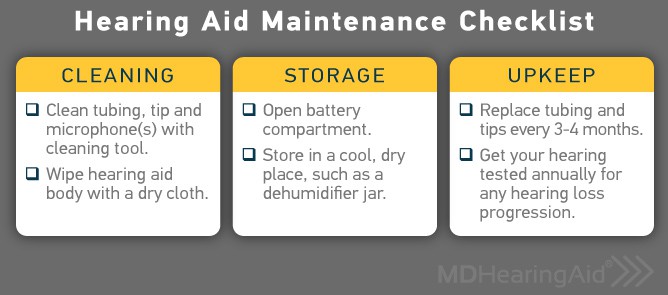Hearing aids can do so much to improve your quality of life. They can motivate you to return to social environments, help stave off dementia and Alzheimer’s, prevent falls, and so much more. They can make your life and the lives of those around you more comfortable, so you and your family don’t have to yell to hear each other or argue over the volume of the television.
However, without regular hearing aid cleaning and maintenance, their effectiveness may wane. Worse, they may stop working altogether. Do you know how to clean hearing aids? Here is a quick guide to hearing aid cleaning, maintenance, and general care to help you keep your hearing aids in tip-top shape for years to come.
Hearing Aid Cleaning
Many people don’t realize how to clean hearing aids, but it’s a simple process once you get the hang of it. Most hearing aids come with a cleaning tool, typically one with a wire on one end (MDHearing’s cleaning tool also has a brush on the other end). If you lose your hearing aid cleaning tool, it’s easy to replace.
It’s important to gently brush the tip of your hearing aid (the part that goes in your ear) and the microphone (typically found on the body of the hearing aid under or near the base of the tubing). Doing this every day helps to get rid of any dust, earwax, dirt, oil from hair, and other debris that muffles the sound or causes whistling feedback. It is best to clean your hearing aid at the end of the day as part of your evening routine.
You should also clean your hearing aid tubes regularly with the wire tool. Start by removing the tubes from the body of the hearing aid. Then, insert the wire through the base of the tubing so that it comes out of the tip (the other end). Wipe the end of the wire clean before pulling it back through the tube, and then wipe it down again. Repeat this step as necessary until the tubing is clean.
Also consider investing in a UV Clean and Dry Box. Using ultraviolet light and a gentle, dry heat, the Clean and Dry Box sanitizes hearing aids, killing germs, bacteria, and viruses.
Hearing Aid Maintenance
Now that you know how to clean hearing aids, let’s talk about general hearing aid maintenance. Like a car, there are several working parts that make a hearing aid work, and practicing good maintenance will keep your hearing aids running at optimum performance. Every three months, you should replace the tips and tubing of your hearing aids, as these do eventually wear out.
Be sure to replace the battery if the sound is weak, intermittent, or gone altogether. The battery’s life depends on your hearing aid’s style and how you use it. You may also want to rotate or flip the controls on the hearing aid every few days or so (probably not while it’s in your ear) to clear any dust or lint that may have gotten caught in the controls.
If you have issues with sound distortion or feedback (whistling), you should try lowering the volume. You may also need to adjust the position of the hearing aid, as it may not be inserted properly. If you continue to experience the issue, you may need a different tip or tube due to a blockage or your desired settings. Or you may just need to clean away any wax or debris.
More Tips for Caring for Your Hearing Aids
Wondering what steps you can take to keep your hearing aids in peak working condition? Know the dos and don’ts of protecting them:
- DO store in a cool, dry place with the battery compartment open.
- DO remove your battery if you are not using your hearing aid for a long period of time in order to prevent corrosion.
- DO use a hearing aid dehumidifier overnight to remove any trapped moisture (such as sweat or oils from your hair).
- DO avoid physical shock to your hearing aid, such as dropping it or stepping on it.
- DO NOT expose your hearing aids to excess moisture.
- DO NOT wear in the rain, wash with water, wear during swimming or in the shower, or use hair spray while wearing.
- DO NOT expose your hearing aids to excess heat.
- DO NOT use a hair dryer while wearing, put through the dryer, or leave out in the sunlight for long periods.
With these simple tips, you should be able to protect your hearing aids and avoid impeding their effectiveness.
Did you know that along with high quality hearing aids, MDHearing offers user-friendly hearing aid cleaning kits?
ORDER TODAY

